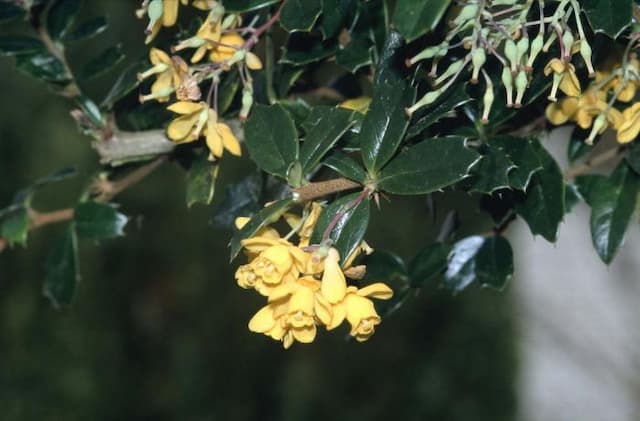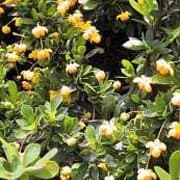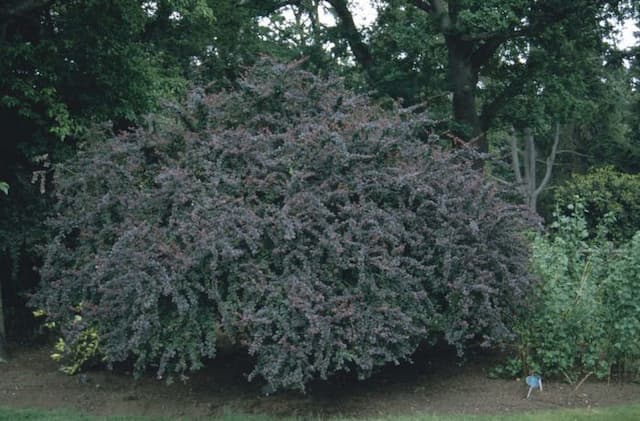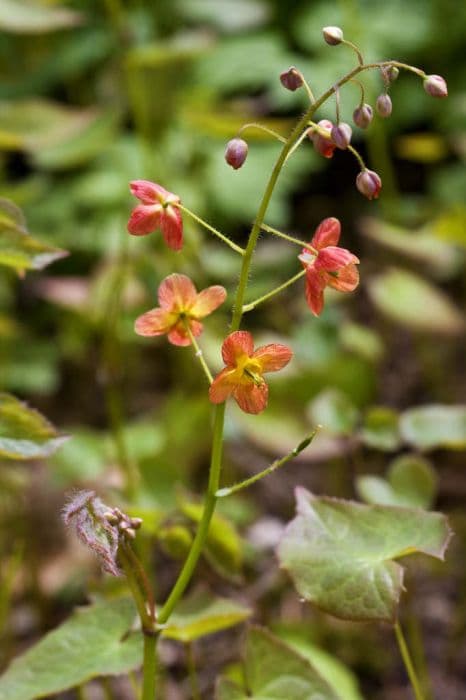Oregon grape Berberis × stenophylla Lindl.

ABOUT
The Oregon Grape is an evergreen shrub known for its dense and spiny, dark green leaves that resemble those of holly. Each leaf is comprised of several leaflets arranged along a central stem, giving it a compound appearance. During the spring, the plant comes alive with vibrant yellow flowers that are small, clustered together in racemes, and emit a noticeable and pleasant fragrance. The blooms are followed by the development of dark blue berries that provide a striking contrast against the foliage. The berries also have a powdery white bloom on their surface and are quite attractive to birds and other wildlife. Overall, the Oregon Grape has a rugged, bushy appearance and can provide a burst of color to the garden with its flowers and fruit, while its foliage remains a constant, glossy backdrop throughout the year.
About this plant
 Names
NamesFamily
Berberidaceae
Synonyms
Oregon Grape, Narrow-leaved Barberry
Common names
Mahonia × stenophylla, Berberis aquifolium var. stenophylla, Mahonia aquifolium var. stenophylla.
 Toxicity
ToxicityTo humans
Oregon grape, which is a common name for Berberis × stenophylla, is not typically considered highly toxic to humans. However, it's important to note that all parts of the plant contain alkaloids such as berberine. Ingestion of the leaves, stem, or roots in large quantities could potentially lead to gastrointestinal discomfort such as nausea, vomiting, diarrhea, or abdominal pain. Consumption should be avoided, and caution is advised as sensitivity can vary between individuals. If significant amounts are ingested, it is recommended to seek medical attention.
To pets
Oregon grape can also pose a risk to pets if ingested, as it contains alkaloids like berberine. While it might not be deadly, eating parts of this plant could lead to symptoms similar to those in humans: gastrointestinal upset, including vomiting and diarrhea. These symptoms could be especially pronounced in smaller pets due to their size and differing metabolism. If you suspect your pet has eaten a large amount of Oregon grape, consult a veterinarian promptly.
 Characteristics
CharacteristicsLife cycle
Perennials
Foliage type
Evergreen
Color of leaves
Green
Flower color
Yellow
Height
4-6 feet (1.2-1.8 meters)
Spread
4-5 feet (1.2-1.5 meters)
Plant type
Shrub
Hardiness zones
6-9
Native area
Hybrid origin
Benefits
 General Benefits
General Benefits- Landscape Appeal: Berberis × stenophylla, commonly known as Oregon grape, adds ornamental value to gardens with its dense, spiny foliage and attractive yellow flowers.
- Low Maintenance: It is known for its drought resistance and general hardiness, requiring minimal care once established.
- Wildlife Attraction: The flowers of the Oregon grape provide nectar for pollinators, while the berries are a food source for birds and other wildlife.
- Year-Round Interest: This evergreen shrub maintains its foliage throughout the year, offering visual interest even in winter months.
- Erosion Control: Its extensive root system can help stabilize slopes and prevent soil erosion.
- Hedge or Barrier: Due to its dense and thorny nature, Oregon grape can be used to create effective hedges or living barriers.
 Medical Properties
Medical Properties- This plant is not used for medical purposes
 Air-purifying Qualities
Air-purifying QualitiesThis plant is not specifically known for air purifying qualities.
 Other Uses
Other Uses- Barberry shrubs such as Berberis × stenophylla can be used as a natural barrier or hedge due to their dense growth and prickly stems, deterring unwanted animals and intruders from entering gardens.
- The thorny branches of Berberis × stenophylla can be incorporated into animal enclosures to provide a natural defense against predators, while still being safe for the animals within.
- With their tolerance to drought and poor soil conditions, Berberis × stenophylla may be used in erosion control, helping to stabilize soil on slopes and disturbed areas.
- The dense, thorny thickets formed by Berberis × stenophylla create protective habitats for birds and beneficial insects, offering them shelter and nesting sites.
- The bright yellow flowers of Berberis × stenophylla provide a valuable source of nectar early in the spring for bees and other pollinating insects.
- Wood from Berberis × stenophylla can be harvested and used for making small woodworking projects like tool handles or inlay work due to its hardness and fine grain.
- Berberis × stenophylla can be used in permaculture designs as part of a food forest underlayer, supporting the overall ecosystem without competing heavily with primary food plants.
- In landscape design, the varying textures and colors of Berberis × stenophylla foliage can be used to create visual depth and contrast in garden arrangements.
- Berberis × stenophylla can act as a nurse plant in reforestation efforts, providing shelter for young trees as they establish themselves in harsh environments.
- The fruit of Berberis × stenophylla, while not typically consumed by humans, can serve as a food source for wildlife, thereby supporting biodiversity within the ecosystem.
Interesting Facts
 Feng Shui
Feng ShuiOregon grape is not used in Feng Shui practice.
 Zodiac Sign Compitability
Zodiac Sign CompitabilityOregon grape is not used in astrology practice.
 Plant Symbolism
Plant Symbolism- Protection: Berberis × stenophylla, commonly known as the Oregon grape, often has spiny leaves which can symbolize protection and defense, suggesting that it can act as a barrier against negative forces.
- Adaptability: As a plant that thrives in various conditions, the Oregon grape symbolizes the ability to adapt to different environments and situations.
- Resilience: The Oregon grape is known for its hardy nature, symbolizing resilience and the capacity to withstand tough circumstances.
 Water
WaterThe Oregon grape holly should be watered deeply but infrequently to encourage a strong root system. As a drought-tolerant plant, once established, it typically requires watering every couple of weeks during dry periods. Aim to provide about 1 to 1.5 gallons of water per plant each time you water, ensuring the soil is moist but not saturated. During the growing season, you may increase the frequency to once a week if the weather is particularly dry or hot. Always allow the top inch of soil to dry out before watering again to prevent overwatering.
 Light
LightThe Oregon grape holly thrives best in full sun to partial shade conditions. It should be placed in a location where it can receive at least 4 to 6 hours of direct sunlight daily, but it can also tolerate some afternoon shade. Avoid deep shade as this can lead to reduced flowering and can make the plant more susceptible to pests and diseases.
 Temperature
TemperatureThe Oregon grape holly is hardy and can tolerate a range of temperatures, making it suitable for many climates. It can survive minimum temperatures down to about 0 degrees Fahrenheit, and maximum temperatures well into the 90s Fahrenheit. The ideal temperature for promoting growth and flower production is between 60 to 75 degrees Fahrenheit.
 Pruning
PruningThe Oregon grape holly should be pruned to maintain shape, remove dead or broken branches, and encourage vigorous growth. Prune in late winter or early spring before new growth begins. You can also prune after the plant has flowered if you need to control its size or shape. Pruning is typically done once a year, but you can also do light trimming throughout the year to remove any undesirable growth.
 Cleaning
CleaningAs needed
 Soil
SoilOregon Grape prefers well-drained soil enriched with organic matter; it thrives in a slightly acidic to neutral pH range, around 6.0 to 7.0.
 Repotting
RepottingOregon Grape does not require frequent repotting and can be repotted every 2-3 years to refresh the soil.
 Humidity & Misting
Humidity & MistingOregon Grape is tolerant of a wide range of humidity levels and thrives in average outdoor conditions without specific humidity requirements.
 Suitable locations
Suitable locationsIndoor
Ensure bright light and well-draining soil for Oregon Grape.
Outdoor
Plant in sunny spot, shield from strong winds, well-draining soil.
Hardiness zone
6-9 USDA
 Life cycle
Life cycleBerberis × stenophylla, commonly known as the Oregon grape or Barberry, begins its life as a seed, which germinates in moist, well-drained soil during spring. After sprouting, it enters the vegetative stage, where it develops a woody stem, spiny evergreen leaves, and a root system. As it matures, it produces clusters of small yellow flowers in the spring, which are pollinated by insects. Following pollination, the flowers develop into small, blue-black, berry-like fruits that contain seeds, completing its reproductive cycle. These fruits are often dispersed by birds and other animals, which leads to the germination of new plants. The Oregon grape is a perennial shrub, and after reaching maturity, it can live and reproduce for many years.
 Propogation
PropogationPropogation time
Spring-Early Summer
The most popular method of propagation for Berberis × stenophylla, commonly known as Oregon Grape, is through semi-hardwood cuttings. This typically takes place in late summer. One would cut a length of stem about 6 to 8 inches (approximately 15-20 cm) that has matured during the current season. The leaves on the lower half of the cutting are removed, and the cut end is often dipped in a rooting hormone to encourage root growth. The prepared cutting is then planted in a well-draining potting mix, with the leafless part buried. The pot should be placed in a warm, shaded spot and kept moist until roots develop, which usually takes a few weeks to a couple of months. Once rooted, the new plants can be gradually acclimated to more sunlight and eventually planted out in their permanent location.









